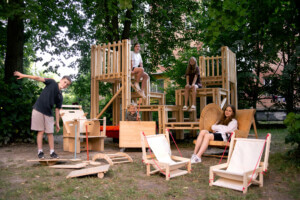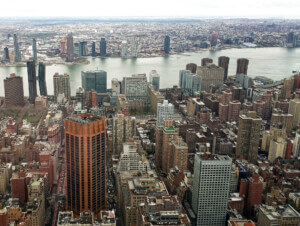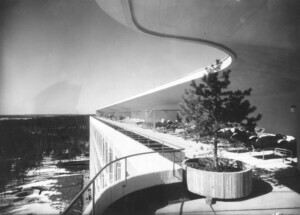As American cities brace for a steep influx of patients suffering from or suspected to be infected by the novel coronavirus (COVID-19), the sprint is on to make up for a woeful dearth of available hospital beds. Per American Hospital Association data, there are 924,000 staffed hospital beds in the country, and more than two-thirds of those are usually occupied. And while the total number of additional hospital required during this mounting pandemic varies day by day, place by place, the only conclusion is that an impossible amount of more beds is needed.
To make up for the narrowing availability, temporary hospitals have been erected or are in the process of being erected in some unlikely places. These urgent acts of emergency-level adaptive reuse, many of them spearheaded by city agencies, intergovernmental organizations, healthcare providers, the National Guard, and the Army Corps of Engineers, have taken root on fairgrounds, in football stadiums, in motels, and in Central Park.
Not all of these converted spaces, however, are being used to treat COVID-19 patients, although many will. Some will provide housing to nurses and doctors, some will act as quarantine units, some will house the homeless, and others will serve as fully functional overflow hospitals dedicated to providing care to patients suffering from ailments that aren’t the coronavirus.
To offer assistance in these conversions, the American Institute of Architects (AIA) has even formed a special task force which will release a comprehensive report in early April to help guide decision-making. “This is a race against time for healthcare facilities to meet bed surge capacity needs” said AIA Academy of Architecture for Health president Kirsten Waltz, AIA, ACHA, EDAC, LEED, who is the director of facilities, planning, and design at Baystate Health in Springfield, Massachusetts. “This task force will help inform best practices for quickly assessing building inventory and identifying locations that are most appropriate to be adapted for this crisis.”
Below are some of the different buildings and facilities being adapted across the country to serve new purposes during the coronavirus outbreak.
Convention centers
Boasting boundless and easily adaptable floor space, robust loading docks for moving in and out a high volume of equipment and gear, high-powered ventilation systems, and more than a few ADA-compliant bathrooms, convention centers are natural places to establish temporary hospitals. Manhattan’s Jacob K. Javits Center, normally one of the busiest convention centers in the United States, was one of the first to undergo the transformation into a sprawling, nearly 3,000-bed capacity overflow hospital operated by the Federal Emergency Management Agency. (The Army Corps of Engineers, the New York National Guard, and a team of civilian staffers can be credited for the rapid turnaround.)
A large number of other convention centers across the country are either being eyed as potential makeshift medical hubs or are currently being converted into them including the Kay Bailey Hutchison Convention Center in Dallas, the Ernest N. Morial Convention Center in New Orleans, Detroit’s TCF Center, McCormick Place in Chicago, the Baltimore Convention Center, the Los Angeles Convention Center, and the Santa Clara Convention Center in California’s Silicon Valley.
Parking garages
While many hospital parking structures are now home to drive-though coronavirus testing sites, in at least one major medical facility, Nashville’s Vanderbilt University Medical Center, beds are being moved into a parking garage to treat those potentially infected by the novel coronavirus at a safe distance from other patients.
This is a photo from a parking garage at Vanderbilt University Hospital in Nashville, TN: pic.twitter.com/phWMTVybVE
— Roshan Rinaldi (@Roshan_Rinaldi) March 22, 2020
Sports fields/stadiums
Originally and still largely used as a military term, field hospitals get their name from their strategic location on wide-open spaces in close proximity to sites of mass injuries and casualties such as, well, battlefields. Twenty-first-century field hospitals are now being erected on battlefields of a different kind that normally see a different sort of frenzied combat: football. CenturyLink Field, home to the Seattle Seahawks, is being converted into a large temporary treatment center by the Army and will be dedicated to treating patients with ailments not related to the coronavirus so that beds in overwhelmed Seattle area hospitals are freed up for those suffering from the deadly respiratory disease.
Elsewhere in hard-hit Western Washington, another 200-bed field hospital will be erected on a turf soccer field in the Seattle suburb of Shoreline. Relatedly, football pitch-bound field makeshift hospitals are now somewhat de rigueur in countries like Brazil.
A section of the famed Billie Jean King Tennis Center at Flushing Meadows, Queens–in better times, home to the U.S. Open—will also be covered into a 350-bed auxiliary medical center by New York City Emergency Management.
The field hospital at Century Link will address non COVID-19 medical needs to free up our health delivery system to deal with this virus.
Thanks to partners at the federal, state and local levels for making this happen. pic.twitter.com/9juaAP5BXf
— Governor Jay Inslee (@GovInslee) March 28, 2020
Decommissioned hospitals
Shuttered hospitals, many of which have never been closed in the first place, are coming back to life due to the coronavirus pandemic. A wide number of bed-equipped, recently closed medical facilities—including the old Sherman Hospital in Elgin, Illinois, San Francisco’s California Pacific Medical Center, and Laurel Regional Hospital in Maryland—have already or will potentially reopen to accommodate a surge of COVID-19 patients or patients in need of other types of urgent care in overburdened areas.
So the shuttered hospital (old Sherman Hospital in Elgin, IL) where the movie “Contagion”was filmed will be reopened to potentially treat Coronavirus patients.https://t.co/vxI56HrNmp
— Rational Galaxy Brain 🌌🧠 (@RationalGenius) March 31, 2020
Dorms/college campuses
With students at an overwhelming number of colleges and universities dismissed from attending in-person classes for the rest of the academic year, an ample amount of available real estate has suddenly opened up. As COVID-19 first began to spread across New York City, New York University pledged to make available some of its now-vacated dormitories for COVID treatment-related purposes if needed. Student housing at New York’s expansive system SUNY and CUNY public colleges could also be potentially turned into emergency medical facilities, quarantine units, and/or temporary housing for healthcare workers.
While dorm rooms can be easily retrofitted into treatment spaces, college and universities are also considering converting or already have converted other on-campus facilities into field hospitals. The McCormack-Nagelsen Tennis Center at the College of William & Mary in Virginia, and Liacouras Center at Temple University in Philadelphia, are two examples of non-dorm collegiate spaces that will serve a new purpose during the pandemic.
NEW VIDEO: A timelapse video of crews transforming Temple University’s Liacouras Center into a field hospital has been released. @MattPetrillo reports. https://t.co/S1OPCYbFNA
— CBS Philly (@CBSPhilly) March 29, 2020
Central Park
Plenty of strange, sometimes disturbing sights can be seen within Central Park. None, however, quite match the surreally sobering heights of witnessing volunteers erect a tent-based respiratory care center in the middle of New York City’s backyard. Said facility, which will have a capacity of 68 hospital beds and also include an on-site morgue, was established this past weekend in Central Park’s East Meadow by humanitarian aid organization Samaritan’s Purse in partnership with Mount Sinai Health System to “provide care for patients seriously ill with COVID-19.”
I don’t think I’ll ever get over this image, not for all of the days I am on this earth. pic.twitter.com/78pTPMUvZ0
— Lisa Lucas (@likaluca) March 30, 2020
Fairgrounds
Generally only used at a very high capacity for a few weeks of the year, fairgrounds over a vast amount of space with the needed infrastructure—electricity, water, various buildings, arenas, parking lots the size of a small town—already in place.
The Santa Clara County Fairgrounds in San Jose, California, for example, will take advantage of this advantageous arrangement and temporarily house members of the region’s sizable, highly vulnerable homeless population during the pandemic. Elsewhere in California, the Orange County Fairgrounds are being mulled as a potential site to accommodate overflow from established medical facilities in the area; it’s a similar story at the Riverside County Fairgrounds in Indio. Outside of California, the massive Washington State Fairgrounds are being considered as an emergency medical site about 30 miles south of Seattle in the city of Puyallup. In Florida, where the virus is on the verge of exploding in certain areas, a 250-bed facility is already under construction at the Miami-Dade Fairgrounds.
In several states, fairgrounds and their parking lots are already being used to host drive-up coronavirus testing sites.
Hotels and motels
Hotels and motels are perhaps the most versatile and, due in part to low occupancy rates brought on by the COVID-19 outbreak, the most readily available spaces to repurpose during a pandemic. Providing privacy, some level of comfort, and isolation, they can be used to treat non-critical patients recovering from the COVID-19-related illnesses, quarantine patients suspected to be infected, house exhausted, high-risk healthcare workers on the frontlines (in sometimes deluxe accommodations), and provide a temporary safe haven to vulnerable populations like the unsheltered. Officials in various cities including New York, Chicago, Seattle, New Orleans, and Oakland, California, have leased hundreds, even thousands, of hotel and motel rooms to be used in various capacities in the coming weeks, with the Army Corps of Engineers working to identify and then convert many of them into fully functional temporary medical facilities. Many, of course, have their own ideas as to which specific hotels should be used.











